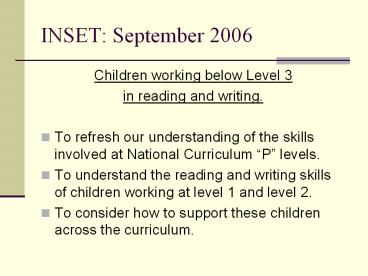INSET: September 2006 - PowerPoint PPT Presentation
Title:
INSET: September 2006
Description:
To refresh our understanding of the skills ... Child has written: I cut out the picture. Teacher prompts may be: 'I cut out the picture with what / how? ... – PowerPoint PPT presentation
Number of Views:59
Avg rating:3.0/5.0
Title: INSET: September 2006
1
INSET September 2006
- Children working below Level 3
- in reading and writing.
- To refresh our understanding of the skills
involved at National Curriculum P levels. - To understand the reading and writing skills of
children working at level 1 and level 2. - To consider how to support these children across
the curriculum.
2
P levels
- Levels prior to Level One
- P1 P3
- Exploration
- Communication
- Response
- Interaction with others
- Learnt responses
- Observation
3
P Levels
- P4 P8
- Subject specific
- Further exploration
- Familiarity
- Sort classify
- Question answer
- Recognition
- Awareness
- Understanding
- Selection
- Repetition
- Imitation
- Choice
- Greater response
- Creation
- Expression
- Play
- Comparison
- Rote learning
4
Level 1c
- Reading
- Can recognise sounds and symbols
- Can identify initial sounds in words
- Understand simple sentences.
- Writing
- Can shape letters correctly
- Sentence attempts require a discussion to be
fully understood.
5
Level 1b
- Reading
- Can read familiar words
- Can identify initial final sounds in words
- Can use their knowledge of sounds to build up a
word. - Writing
- Can build short phrases, using words they
recognise - All letters can be clearly recognised
- Phrases/statements show use of full stops
- Writing can be understood without discussion.
6
Level 1a
- Reading
- Can use their knowledge of letters, blends and
sight recognition words to read simple texts. - Writing
- Clearly shaped letters
- Phrases and statements to show ideas
- Use of full stops and capital letters
7
Strategies to Support Level One
- Ideas may include
- Pair children with a more able reading buddy.
- Text given should only be very simple sentences
without connectives, including pictures for
additional clues. - Ensure child is following reading text with
finger. - Play Spot the key word before or during reading
or ask child for next word in the sentence. - Writing frames to include mixed up sentences to
re-arrange basic cloze procedures with initial
letters given for missing words key words/word
banks simple sentence starters. - Read back written attempts with the child.
- Provide subject specific word banks to support
writing,
8
Level 2c
- Reading
- Read word to word but need help to understand
meaning - Can recount main facts with support
- Writing
- A series of simple sentences
- Incorrect spelling uses phonetics
9
Level 2b
- Reading
- Reads simple sentence texts with basic
punctuation - Combine phonic, graphic, grammatical and
contextual clues to gain meaning - Writing
- Some sentence punctuation
- Plausible spelling attempts
- Variation in simple sentence structure and word
choice.
10
Level 2a
- Reading
- Reads unfamiliar texts accurately, beginning to
use intonation - Can identify main points express opinion
- Writing
- Beginning to write descriptively to add detail.
- Accurate use of full stops and capital letters
- Spelling of monosyllabic words is accurate, with
phonetically plausible attempts at longer,
polysyllabic words.
11
Strategies to Support Level Two
- Ideas may include
- More able reading buddy with time to talk about
text prior to class discussion. - Recount phrases / facts from text
- Listen to child whilst reading read along with
child ask whole class to read aloud
simultaneously. - Expect 6 10 decent simple sentences provide
target number. - Key word lists/word banks
- Sentence starters with space to add sentences of
their own. - Verbal prompts to extend / improve sentences
for example - Child has written I cut out the picture.
- Teacher prompts may be I cut out the picture
with what / how?































